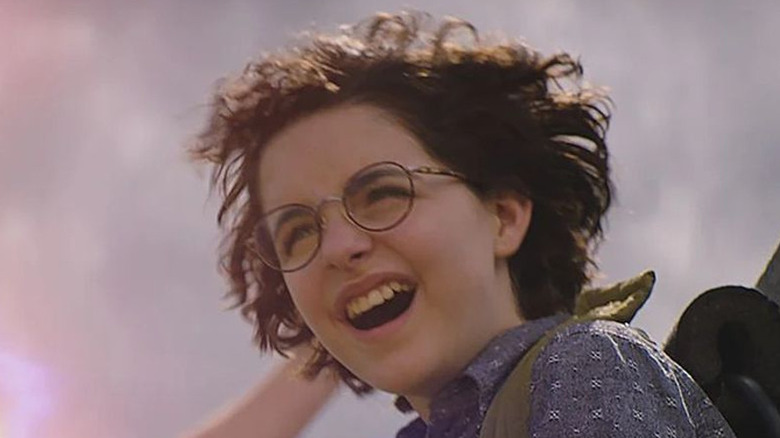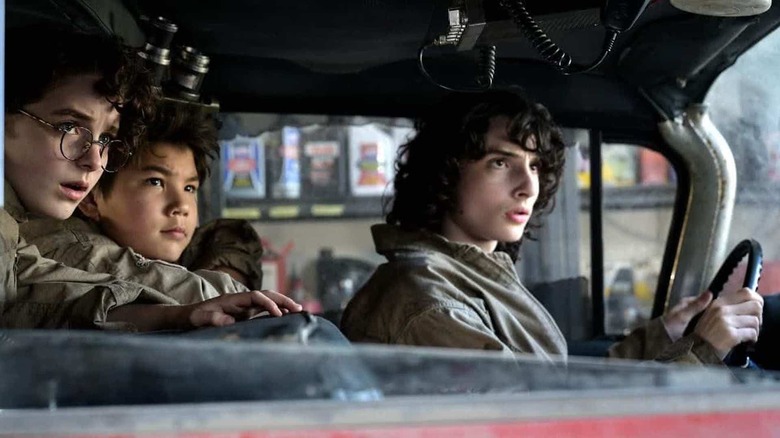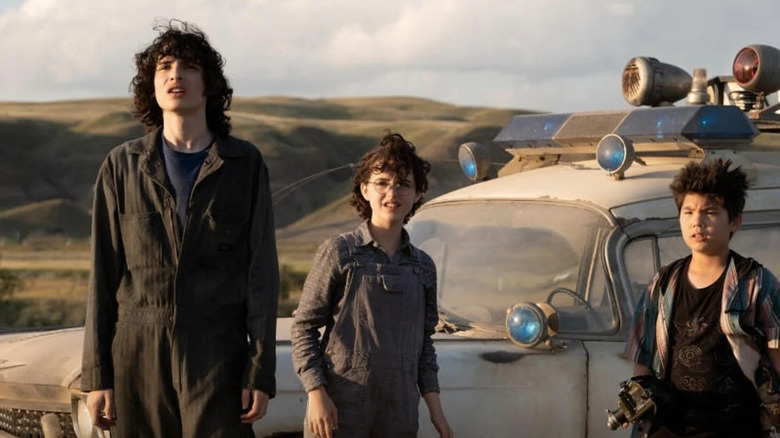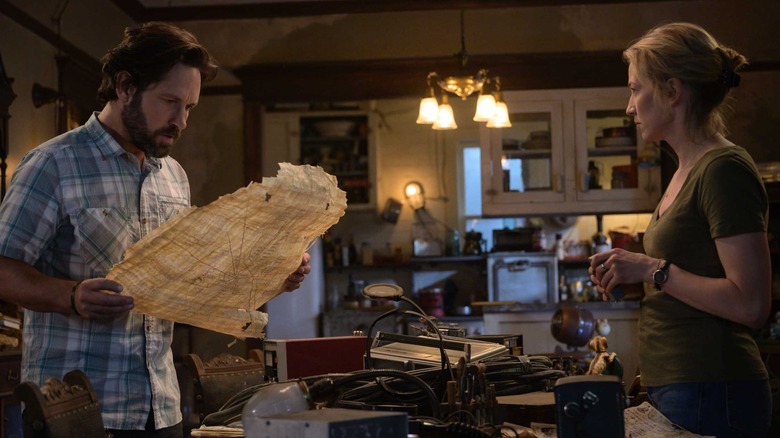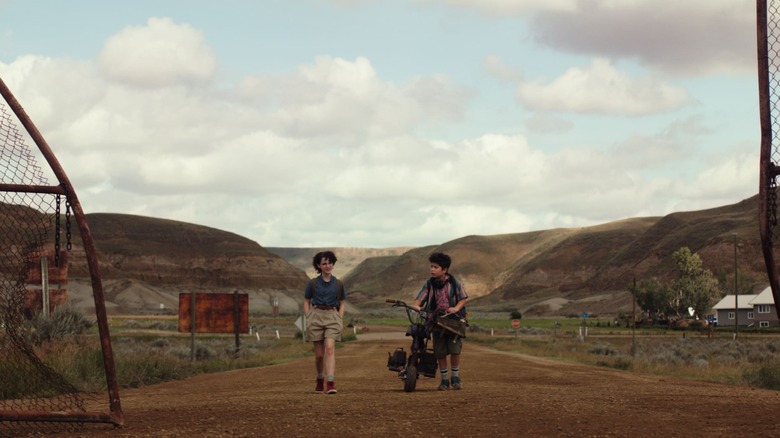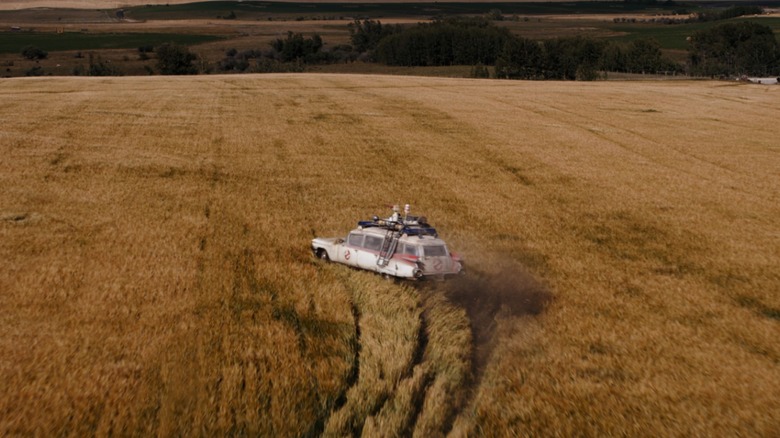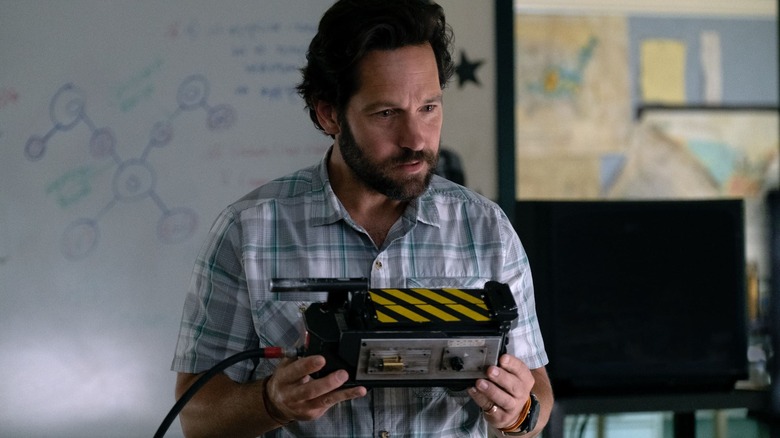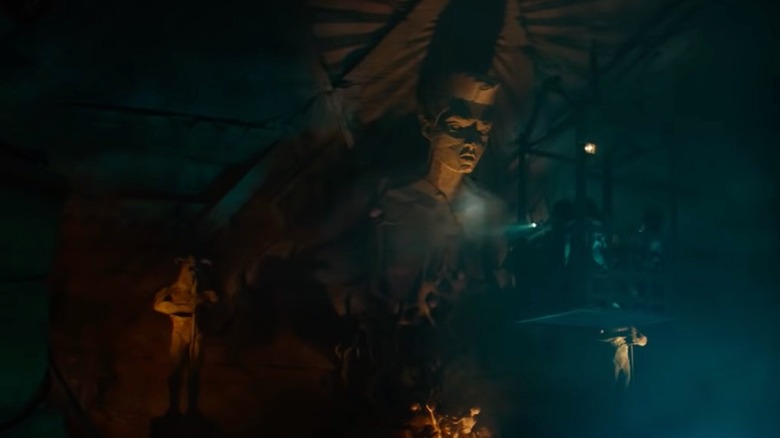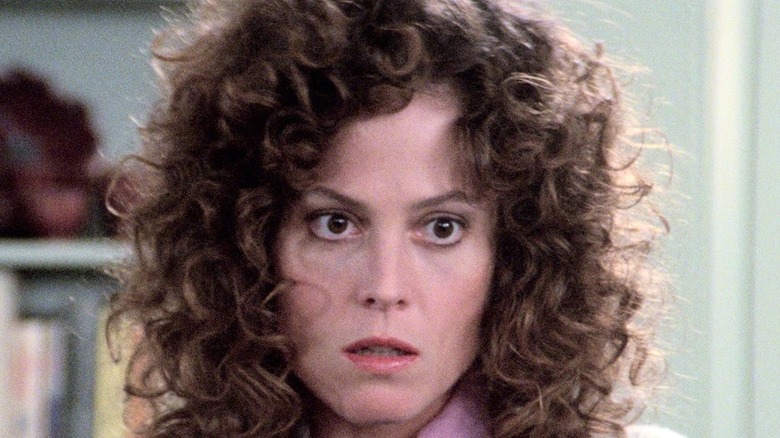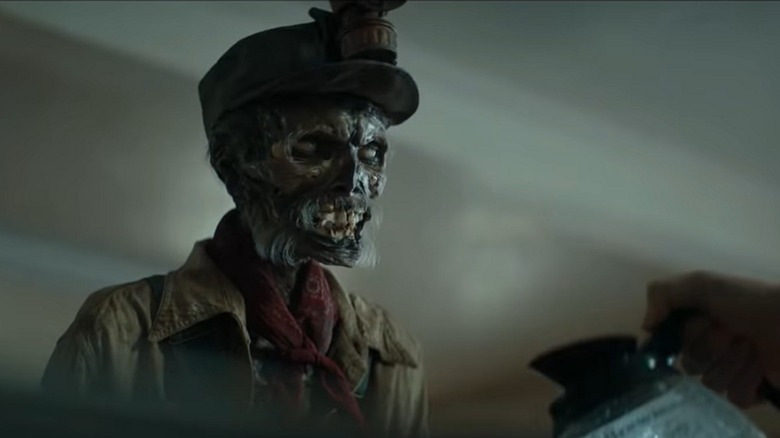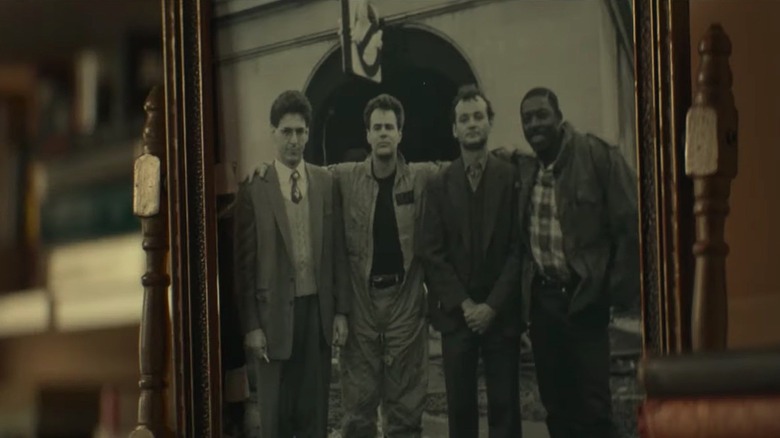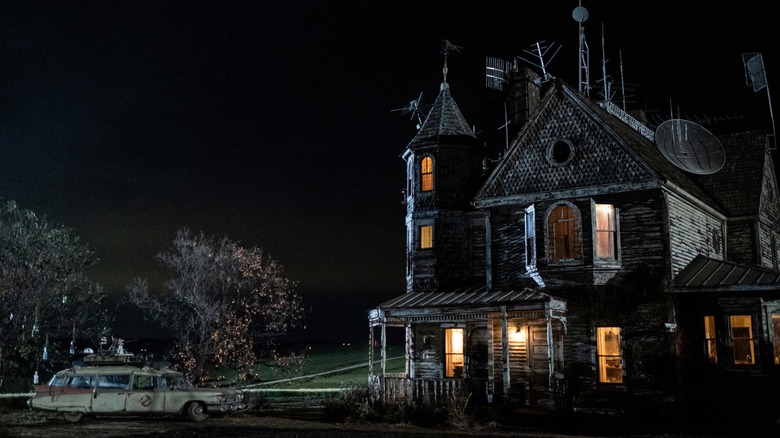The Ending Of Ghostbusters: Afterlife Explained
Though the franchise has lived on through video games, comic books, animated series, and a movie reboot with an all-female team in 2016, the main saga that began in "Ghostbusters" in 1984 was largely dormant for years after the release of "Ghostbusters II" in 1989. That meant that when "Ghostbusters: Afterlife" was announced in 2019, it left fans itching to learn what had been happening to the team in the 30 years since we last saw them, and how the new film would expand on the franchise lore.
From the very beginning, "Ghostbusters: Afterlife" seemed primed to tell the story of a new generation of paranormal investigators by incorporating the family of Egon Spengler into the narrative through an exploration of his grandchildren's lives. Plus, by tying the new narrative directly to a classic "Ghostbusters" monster, the film created a link stretching all the way back to 1984 while also paving the way for the future. So, now that the film is out in the world, let's explore those connections, what they mean, and how the ending leaves the franchise. This is the ending of "Ghostbusters: Afterlife," explained.
And, of course, there are SPOILERS AHEAD FOR THE ENTIRE MOVIE, so proceed with caution.
Phoebe's future
If you have to single out one character who forms the character of the "Ghostbusters: Afterlife" narrative, you definitely lean in the direction of Phoebe (McKenna Grace), the brilliant young granddaughter of Egon Spengler who cracks open the mystery at the heart of the film and forms a connection across generations of her estranged family in the process. At the beginning of the film, Phoebe is an outsider not just in Summerville, but in her own family, as her mother only half-jokingly tells her things like "don't be yourself" in an effort to get her to form connections with people. By the end of the film, she's the heart of her extended new family and friend group, a hero to the world (even if they don't know it), and a newly minted Ghostbuster, continuing the tradition set up by her late grandfather.
We see Phoebe's journey to self-actualization, but the question remains: What happens to her next? It's easy to imagine her as the first junior member of the Ghostbusters, attending a fancy science-based New York City school by day and wielding a proton pack by night. It's also easy to see her staying in Summerville for a while, archiving and continuing her grandfather's work as she digs deeper into the mysteries of Gozer. Whatever happens, Phoebe has a bright future not just because of what she's achieved, but because she's learned how to really be herself.
Trevor's future
Though his personal journey in the film is considerably less developed than his sister's, Trevor Spengler (Finn Wolfhard) still gets an arc across "Ghostbusters: Afterlife," one that seems to have implications for his future as well. Though he definitely considers himself the cool one in his family, Trevor is still a bit of an outsider thanks to his fresh arrival in Summerville. That changes when he meets Lucky (Celeste O'Connor), a girl who not only takes him under her wing, but also seems to take a very personal liking to him along the way.
By the end of the film, Trevor has become a Ghostbuster of sorts alongside his sister, despite his lack of scientific knowledge or particular enthusiasm for the paranormal. What he does have, though, is a sizable sense of mechanical wisdom, as evidenced by his ability to fix ECTO-1 with only a tiny bit of supernatural help from his grandfather. It's easy to see him sticking around Summerville with Lucky, but it's just as easy to see both of them moving on to New York City, where Trevor basically becomes the Winston of the next generation of Ghostbusters. He's not a scientist, but he's a hard worker with a sharp mind, and he's willing to dig in deep for the people he cares about.
Callie and Gary's future
At the beginning of the film, Callie Spengler (Carrie Coon) feels like a failed mother. She hasn't been able to make life in the city work out, her kids are growing and changing in ways she doesn't fully understand, and her only refuge in life is a broken down old house in the middle of Oklahoma, left to her by a father who never had time for her. As she admits in a half-joking way during "Ghostbusters: Afterlife," she feels like her soul is slowly dying.
But like every other member of her family, over the course of the story Callie finds a new sense of purpose that begins when she sees her children coming alive in ways they never have before, and ends when she realizes the father she never really knew not only cared about her, but did everything he could to protect her from forces she couldn't understand at the time. That new sense of purpose also comes through the arrival of Gary Grooberson (Paul Rudd), the local seismologist and teacher who not only adores her, but adores her kids as well.
So, what happens to them next? Having made peace with her family's past, Callie seems ready to build a new future with Gary, whether that's in Summerville, New York City, or somewhere else entirely. A new family unit has grown out of the ashes of the old one.
Podcast's future
Though much of the film centers on the Spengler family, a good portion of the plot in "Ghostbusters: Afterlife" is pushed forward by the kid known as Podcast (Logan Kim), Phoebe's summer school friend with a deep interest in mysteries and other assorted occult lore. Though Phoebe brings the scientific know-how and observational powers to the power, Podcast brings the belief in the supernatural that allows her to see what's right in front of her, and the research skills to dig into what's really going on. By the end of the film, it's clear that he's basically the Raymond Stantz of the new Ghostbusters team, and Ray himself (Dan Aykroyd) makes it clear that he's a fan of the young podcaster.
Obviously, Podcast's role in what went down in Oklahoma could mean a big boost to his subscriber base, provided enough people know that anything went down at all, but it will also mean his appetite for more supernatural mysteries will only grow with time. This is a young man who will keep pushing to solve more paranormal mysteries, and that will either lead him in the direction of full-time Ghostbusting, or in the direction of media and entertainment, much like Peter Venkman in "Ghostbusters II."
Summerville's future
"Ghostbusters: Afterlife" is largely set in Summerville, Oklahoma, an out of the way former mining town that's basically a tiny dot on the map with seemingly nothing to show for itself but a half mined-out mountain and a surprisingly cool carhop burger joint. By the end of the film, though, Summerville has become the epicenter of supernatural activity on Earth, as the discovery of a temple built by an eccentric architect to summon an ancient Sumerian god propels the Ghostbusters into a new adventure.
After Gozer is trapped by the team, things seem poised to quiet down in Summerville, and we see the old ECTO-1 car back in action in New York City, but that doesn't mean the Oklahoma town won't get any more attention. If it truly did serve as the force behind a supernatural re-awakening, it's bound to attract all manner of investigators, scientists, tourists, and media, turning a once sleepy town into a minor boom of activity in the middle of the American plains. Podcast won't be the only person investigating its mysteries anymore, and that could both lead to good and bad things for the town, particularly if intrepids occult sleuths start examining that old temple a little too closely...
Will Gozer stay busted?
In the original "Ghostbusters," the team faced Gozer as the ancient god took the form of a destroyer of their choosing, which thanks to Ray's random thought process turned out to be a giant representation of the Stay-Puft Marshmallow Man. After crossing the streams of their proton packs, the Ghostbusters were able to defeat Gozer's destroyer form and thus banish the god back to its own dimension, seemingly for good.
Of course, we now know that Gozer was just biding their time until they could re-enter our dimension, but thankfully Egon Spengler had developed a plan. Instead of just banishing the creature yet again, he built an elaborate, high-powered trap on his homestead in Oklahoma, waiting for the moment that he could lure Gozer in and spring it. It didn't work for Egon, but his granddaughter, her family and friends, and the surviving original Ghostbusters were able to capture the creature.
The question is: With Gozer now contained to a trap, what happens next? Gozer was able to break one of the standard traps wide open earlier, so what's stopping them from tearing through this system eventually? Plus, Gozer's temple in Oklahoma was so elaborate and the plan so firm, it's quite possible that there are other worshippers out there, just waiting for the next big date when they can free their God again. There's a good chance Gozer will need to be busted at least one more time.
One more catastrophe?
Over the course of the film, the mystery at the heart of "Ghostbusters: Afterlife" is slowly unearthed, often quite literally, through the exploration of the old Sandor mining complex, specifically the mountain where Selenium was mined in the early 20th century. Eventually, Phoebe, Trevor, Podcast, and Lucky discover a tomb/temple complex beneath the mountain built in tribute to Gozer, the Sumerian god who first appeared in the original "Ghostbusters" film.
The tomb is full of interesting details, but Phoebe picks up one in particular that stands out with regard to the franchise's future: A stone relief that features carved dates of various years in which major catastrophes occurred, including the 1883 Krakatoa eruption, the 1908 Tunguska event, the "Manhattan Crossrip" of 1984, and the predicted rise of Gozer in 2021.
What's especially interesting about these carvings is that there appears to be another, partially obscured date carved into the rock sometime after 2021. It's difficult to make out exactly when it is, and of course we have no idea what it could reference, but Gozer's closest followers probably have some idea, and the presence of the temple in Oklahoma suggests there could be others out there.
So, what future catastrophe awaits this next generation of Ghostbusters? Time will tell.
Peter and Dana
"Ghostbusters: Afterlife" is a movie packed with cameo appearances, but though she was confirmed to be part of the film months before its release, one former "Ghostbusters" star waited until the very end to show up: Dana Barrett (Sigourney Weaver), the New York City woman and former victim of Gozer who developed a romance with Dr. Peter Venkman (Bill Murray) in the first film and rekindled it in the second.
Dana finally appears in a mid-credits scene in the film that echoes our first meeting with Venkman back in 1984, as she runs his old shock treatment ESP test on him. There's clear flirtation happening between the two of them, and Venkman even throws out the phrase "true love" at one point, but because of their previous dynamic, it's hard to tell if they're actually a couple, or just up to their old conversational tricks. It's such a brief scene that we don't get too many clues, but it's clear that the filmmakers at least want us to think about what might be happening. Perhaps an eventual "Afterlife" sequel could clear up just how well Peter and Dana are getting along these days.
How many ghosts are left to bust?
In one crucial scene in "Ghostbusters: Afterlife," Phoebe calls the old number in a vintage Ghostbusters commercial and is connected to Ray Stantz's occult bookshop in New York City. After a little nudging, she's able to get Ray to tell her a little of the backstory behind the breakup of the Ghostbusters. According to Ray, it had its roots in two things: Egon's obsession with the re-emergence of Gozer, and an almost complete lack of new calls for supernatural assistance.
So basically, since the 1980s, ghosts have either not been a problem at all, or they've been such a negligible problem that the Ghostbusters weren't able to keep the business afloat even in the historic metropolis of New York City. Gozer's return obviously shook at least a few ghosts loose, and at the very end of the film we see ECTO-1 back in action, but how many ghosts are there to really bust? Gozer is, after all, in captivity now, and the portal that awakened them seems to be dormant. Has something else shaken loose that will guarantee continued work for the team, or are they just going to do what they can with what they have for as long as possible? Obviously, a sequel would help to clear this up quite a bit.
The future of the Ghostbusters
In the post-credits scene of "Ghostbusters: Afterlife," Winston Zeddemore ( Ernie Hudson) and Janine Melnitz (Annie Potts) meet in New York City to discuss the future of the Ghostbusters team. Winston's success in the world of finance means that he has considerable resources at his disposal, enough to buy back the firehouse, restore ECTO-1, and get the team up and running again, because as he notes, he'll "always be a Ghostbuster."
The question remaining is what exactly that team will look like once Winston and Janine are all set up again. Will the Spengler family move back to New York and be a part of the next era of the company, with Janine and Winston running the show behind the scenes? It seems likely that if Winston and Janine are back in the game, Ray would have a hard time not lurking around the firehouse himself, training new recruits. And Venkman? Well, he might not care for busting anymore, but even if he doesn't, he could be persuaded to handle the marketing side of things.
It's easy to imagine that crew coming together with the Spenglers to launch the next phase of Ghostbusters Inc., and perhaps even do what previous sequel ideas had in mind and franchise the whole thing, with locations in every major city. Whatever the case, the old firehouse is about to power up again, and that trap grid in the basement might have a few old terrors still lurking in it.
The legacy of Egon Spengler
Though Phoebe is pretty much inarguably the star of "Ghostbusters: Afterlife," you could make the case that the most important character in the overall story is actually her deceased grandfather, Dr. Egon Spengler (the late Harold Ramis).
By the time of "Afterlife," Egon is a ghost, lurking in his house in Oklahoma and biding his time until his genius granddaughter puts all the pieces of his plant to defeat Gozer together. While that happens, we learn that somewhere along the way, he decided he had to make a massive sacrifice in his quest to keep the world safe from a dark god. When he couldn't convince his fellow Ghostbusters that Gozer was about to resurge, Egon instead cut himself off from everyone with the exception of Janine, moved to Oklahoma to be near the old Gozer site, and abandoned both his family and his friends for their own protection.
It's a move that speaks to his obsessive nature, but also to his ability to think in terms of the greater good. Egon's choices could easily be dismissed as part of his character as the coldest Ghostbuster, but it took an enormous level of love and care for the people in his life to do what he did. It was a sacrifice that the film only scratched the surface of, but in the end, it proved that Egon Spengler may have had the biggest heart of all of the Ghostbusters.
